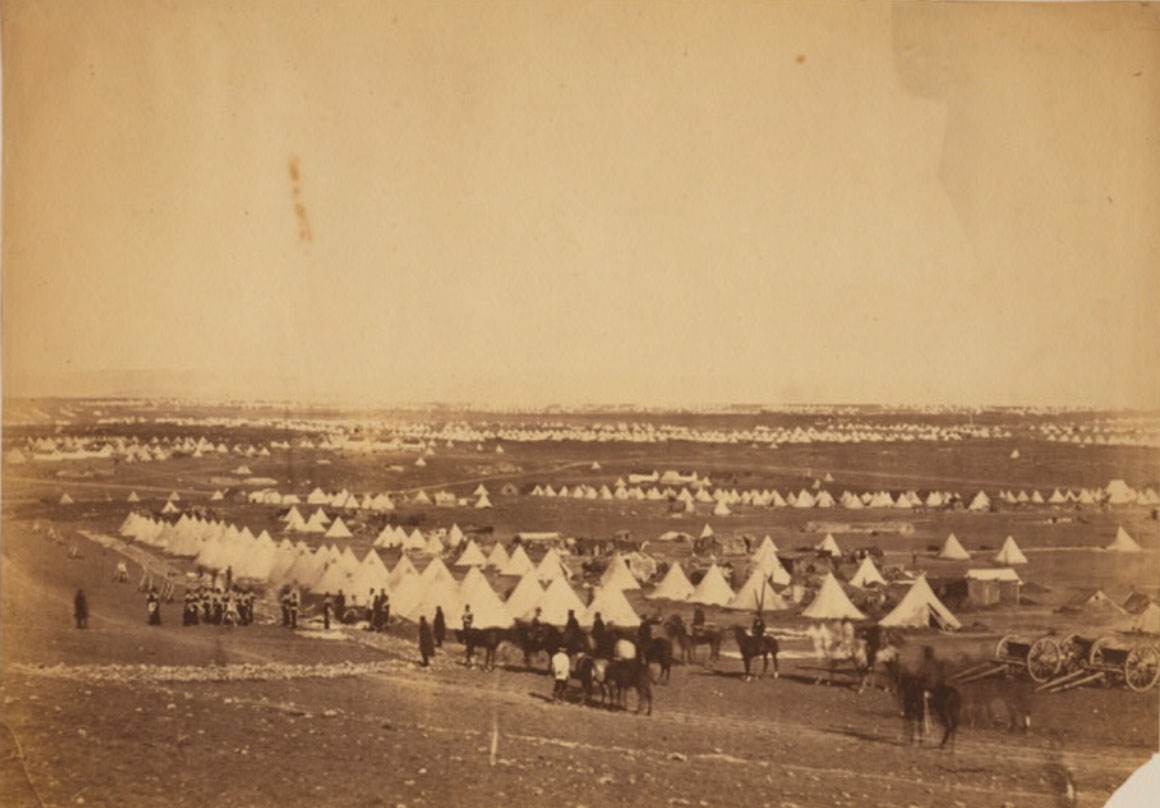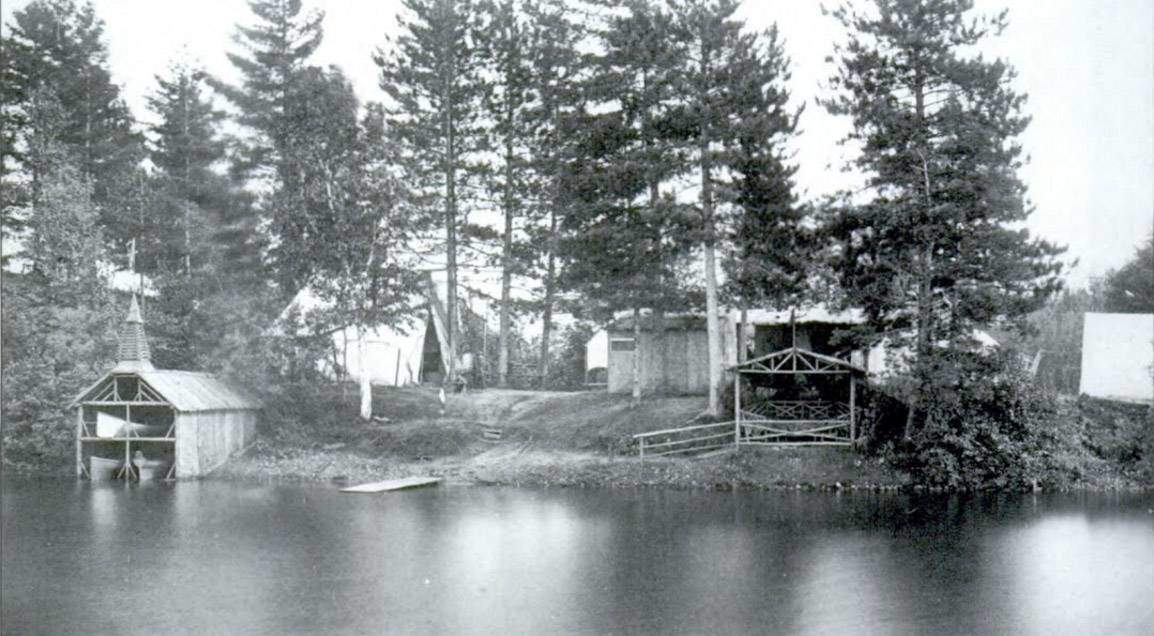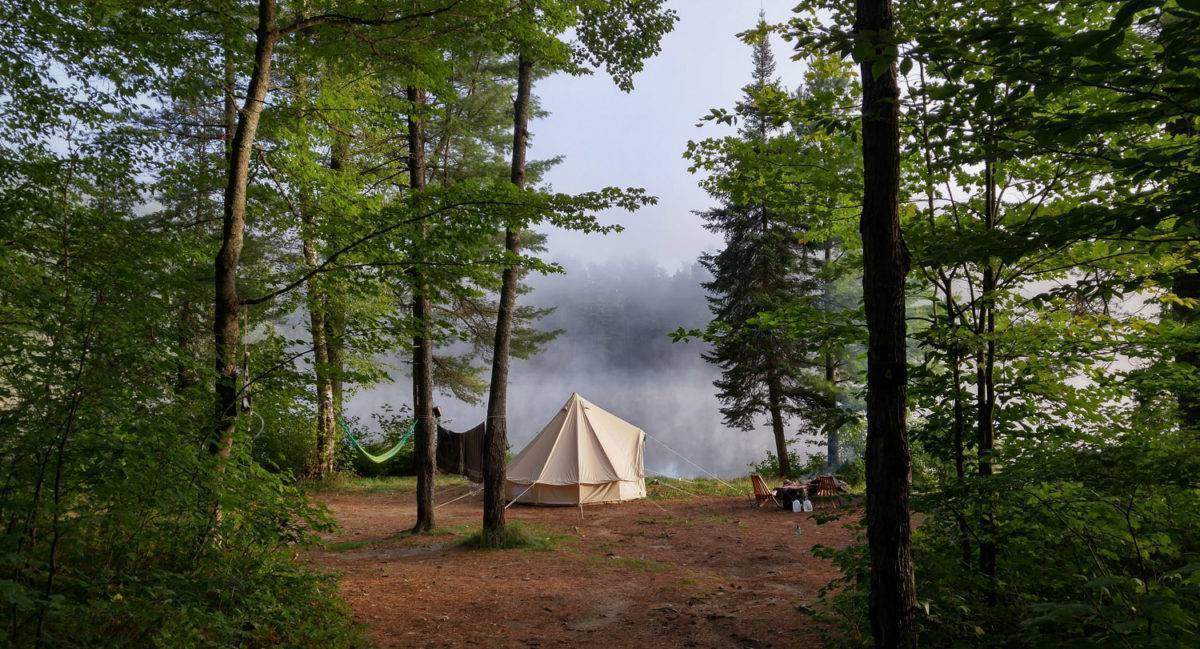Throughout my twenties, I went camping every so often, always the tag-along of someone who had all the gear. It was usually for just a night, somewhere within a couple hours of New York City by car. When I met my now-boyfriend of six years, the tag-along scenario became a more permanent one, and I gradually began contributing to the enormous box in the basement full of tents and camping showers and folding chairs and battery-powered lights. Along with building a campfire, this became one of the joys of camping for me: The quest to make doing so as homey as possible. I don’t camp, it turns out, to rough it. I do it to spend time in a picturesque place; I do it because I love building fires; and I do it, I realize now, to satisfy my latent homesteader fantasies.
Enter the bell tent.
The bell tent, sweetly named and sincerely constructed; a canvas dwelling propped up by a single center pole, creating a cone; a relic of the time before synthetic materials, invented apparently hundreds of years ago, and used in the 19th century to house troops during battle.



As would soon prove wonderfully appropriate, similar canvas tents also sprang up in the Adirondacks of upstate New York in the 19th century, when wealthy urbanites from New York and Boston began “summering” there. The tents were predecessors to the permanent structures comprising the “great camps” to be built by the likes of the Rockefellers in coming decades.



Bell tents, if they are known at all in America today, come with associations that tend to align with Coachella. You can rent them for that particular event, and they make for good Instagrams, so. In recent years, they’ve also helped “glamping” become a word.
I had only a vague notion of the bell tent until—of all things—my dog got very sick and I couldn’t leave her behind for my family’s annual week in the Adirondacks at a place that doesn’t allow dogs. Camping nearby emerged as a potentially viable solution.
I took to the internet to research what might be possible, and soon discovered the bell tent and the many traits it has to recommend it—more on each below–including its aforementioned canvas material, its large footprint, the light it creates inside, and the fact that you can put a wood burning stove in it.
I also discovered that it’s mostly available in the UK, where camping rings in as more of an extended holiday event than it does here in the States. There are a couple of American companies that specialize in bell tents, presenting them in a sort of small batch, commercialism-as-authenticity kind of way. I’m not immune to that kind of branding, and took a good hard look, but neither of these companies convinced us that their product was better built, much less more authentic, than others out there, and furthermore, they don’t sell tents that are stove-ready, a dealbreaker for us.
We looked at some tents available from UK websites, figuring this is a good time to buy items from that country, with its depleted currency rates. But ultimately, and we should have seen this coming all along, we ended up where life increasingly takes us these days, on Amazon, where we bought this tent, there existing no compelling reason not to. Everything about it turned out to be great, except that the zipper on one of the windows was broken on arrival, allowing that window to open only halfway.
We hemmed and hawed over the 4-meter versus 5-meter sizes. Ultimately, we went with the lighter weight and smaller footprint of the 4 meter, which will probably end up being the right size for us 75 percent of the time. It translates into a 13-foot diameter. Again, more on that in a minute.
When the time arrived, it was a late afternoon and we rolled up to a campsite on Mountain Pond that my dad, having arrived in the area a couple days before us, had scouted out and saved for us all day, sitting in a plastic chair in the center of the plot and reading his book. (The Adirondacks boast a number of well-maintained, first-come-first-serve campsites, free of charge.) The setting was perfect, idyllic, private, and right on the water, with its own small beach. With my whole family looking on, wondering if we’d succeed before sunset, we got to work. You can read more about the assembly process that took place in the guide to putting up a bell tent that I put together for Flung. To summarize, assembly was a success, and took about 45 minutes.
We went to dinner at my parents’ cabin and returned to the campsite too late to build a fire there. Instead, we took our dog and a couple of hand warmers into the bed with us. Our dog burrowed, and I think slept the best of all of us, and we slept well. In the morning, we finally built that fire, brewed coffee, watched the thick mist over the pond grow thinner and then disappear. Over the next few nights, we did build fires at night as the loons on the pond called their haunting calls–the best sound in nature, for my money–and we lay in the hammock strung between two trees behind the tent, and we swam.
We also made the tent truly livable–aka I got carried away with the homesteading. In another post, I detail all of the items we used to make the most of our bell tent experience.
All other things being equal, the appeal of the bell tent lies in its aesthetic superiority and its breathability. The thing truly turns a plot of ground into a marvel. Campsites, all of a sudden, become the thing of not only natural beauty but also of engaging design; less a pit stop for sweaty hikers and more a rough draft of civilization. Which as a homesteader is so, so fun.
More About Bell Tents…
Canvas vs. Nylon: Waking up from a night in a nylon tent, as anyone who’s done so knows, feels damp, it feels stale, it feels like you’ve never needed so badly to wash your face. Canvas is totally different, because unlike nylon, canvas breathes. In the five nights we slept in it, our bell tent never felt stuffy, even as it remained warmer than the outdoors, which at night fell to as low as 35 degrees.
Furthermore, the natural color of the canvas created a warm, glowing light inside the tent during the daylight hours, making it a pleasure to settle into if a cold breeze or some rain blew in.
It rained on two of our five nights in the tent, one of those a significant downfall. Completely manageable amounts of water did gather around the edge of the groundsheet on the inside of the tent, which the company warned us to expect the first time it gets rained on. Apparently, the cotton canvas tightens up that first time it gets wet, after which the tent becomes almost fully waterproof. We’ll have to wait to confirm that until our next trip.
Size: Bell tents come in standard sizes of 3-meter, 4-meter, 5-meter and 6-meter, with the 4- and 5-meter sizes being the most common. We bought the 4-meter tent, which gave us 133 square feet of floor space to work with. That was more than enough for a queen-sized bed, a set of chairs, a small “changing area’ and a wood burning stove, when we do end up buying one.
That’s a lot of square footage for some campsites. The 5-meter tent covers 211 square feet. While the extra space and height would be nice at times, we felt the 4-meter would allow us more flexibility.
The tent’s weight also influenced our decision. Our 4-meter weighs 50 pounds, all in, while the 5-meter weighs 75 pounds. That’s a big difference, especially if, like me, you’re scrawny.
My boyfriend, who is 6’5”, says he would have appreciated a little more space to stand up straight inside the tent—because the tent’s walls slope downward, he could stand fully only within three feet or so of the center pole.
Putting It Up: We came at the tent with the expectation that it would prove a more complicated task than the tents we are accustomed to.
We didn’t time it, but I’d say it took 40 minutes or so. Next time, now that we know what we are doing and all the guy ropes are already in place, I feel confident we can do it in under 20. See Flung’s guide to putting up a bell tent for a lot more info.
The Removable Groundsheet: Bell tents come either a) with an attached groundsheet, b) with a removable groundsheet, or c) with no groundsheet. Unless you’re building a wooden platform to place the tent on, you’ll want a groundsheet. I strongly prefer the removable kind, for three reasons: It enables the tent to be opened up completely on hot days; the tent is easier to carry into and out of campsites in two pieces; almost inevitably, the groundsheet will be wet and dirty on the bottom when you dissemble the tent, and removing the groundsheet means you can hang it to dry while packing away the rest of the tent.
The Stove Situation: While I live out my homesteader fantasies, my boyfriend lives out his post-apocalyptic ones. Both involve making do in relatively primitive conditions. And I’m just saying, in either early 19th century America or in the dark days following the apocalypse, how glad would you be to have a tent with a wood burning stove in it? We all have our version of romance…
We haven’t purchased the stove yet, but birthdays and the holidays are right around the corner, and so too maybe the apocalypse. Check back for more info as soon as we get it.
-by Sarah Stodola






